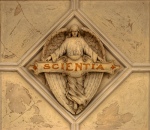The Cambrian period (542 – 488 mya) is characterized by an evolutionarily rapid diversification of metazoan life forms. It is during this Cambrian explosion that most of the modern phyla, including arthropoda, first make a definitive appearance in the fossil record. The biota of this period is spectacularly preserved in the renowned Burgess Shale of British Columbia as well as other formations in China, Greenland, and Sweden.
Following the Cambrian, and near the end of the Ordovician period (488 – 443 mya), there was another relative explosion in diversity of biological forms, termed the Great Ordovician Biodiversification Event. Whereas the Cambrian explosion saw the appearance of the major modern phyla, the Great Ordovician Biodiversification Event is characterized by a diversification of life forms within those phyla, and the abrupt absence of the prototypical Cambrian forms.
Previously, the early Ordovician period was conspicuously absence from the fossil record, obscuring the fate of the Cambrian evolutionary forms. Now this gap in the fossil record has been filled with the discovery of rich marine fossil beds in southeastern Morocco. These formations show that a wondrous diversity of Cambrian forms persisted into the Ordovician and formed a connective link up to the Great Ordovician Biodiversification Event.
This new discovery is published in Nature this week, and you can read more, here.
Below are some examples of beautiful arthropod fossils from the Moroccan Ordovician formation.

Marrellomorph arthropod, a strange and poorly understood early-branching arthropod group with no living descendants. Van Roy et al., 2010.

A stalked barnacle (left) and Xiphosurids (right and bottom), related to modern horseshoe crabs. Van Roy et al., 2010.
References:
- Van Roy, P., Orr, P., Botting, J., Muir, L., Vinther, J., Lefebvre, B., Hariri, K., & Briggs, D. (2010). Ordovician faunas of Burgess Shale type Nature, 465 (7295), 215-218 DOI: 10.1038/nature09038

















I saw that – those are some spectacular fossils. I’m especially intrigued by the stem arthropods (of course) – what a bizarre diversity of forms there must have been as the major classes were beginning to sort themselves out.
Thanks Michael. I’ve pretty much stopped reading Nature,but it is good to know they still have some exciting papers. My wife and I have always made good use of the Burgess Shale fauna in first year lectures (and were geeky enough to include a hike to the shales as part of our honeymoon). Spectacular to see them mixing into the Ordovician fauna.
Grest work with your blog – it has become one of the few I check almost daily.
Thank’s for the kind words Dave.
The Burgess Shale is pretty high on my list of biological Meccas. Even without the amazing fossils the area looks absolutely gorgeous.
Why users still use to read news papers when in this technological world everything is
available on net?
Hi there exceptional blog! Does running a blog such as this require a large amount of work?
I’ve virtually no understanding of coding however I had been hoping to start my own blog soon. Anyhow, should you
have any suggestions or techniques for new blog owners please
share. I understand this is off subject nevertheless I simply wanted to ask.
Thanks a lot!
I couldn’t refrain from commenting. Perfectly written!
Definitely believe that which you said. Your favourite reason seemed to be at the web the simplest thing to
understand of. I say to you, I certainly get irked at the same time as other
folks think about worries that they just don’t
realize about. You managed to hit the nail
upon the top and also outlined out the entire thing without having
side-effects , folks can take a signal. Will probably
be again to get more. Thank you
This is very attention-grabbing, You’re a very skilled
blogger. I’ve joined your rss feed and stay up for searching for
extra of your excellent post. Additionally, I have shared your website in my social networks